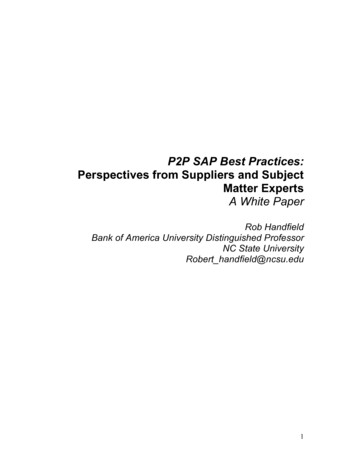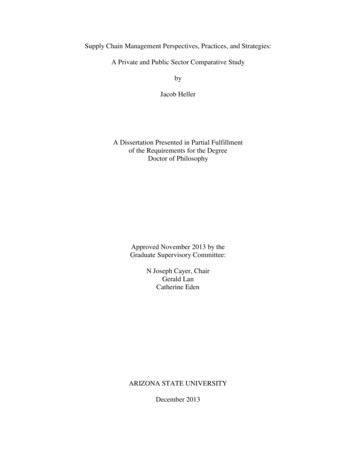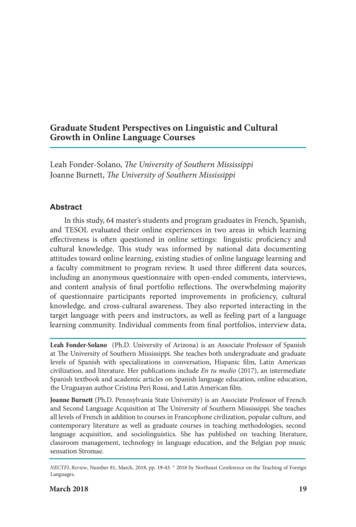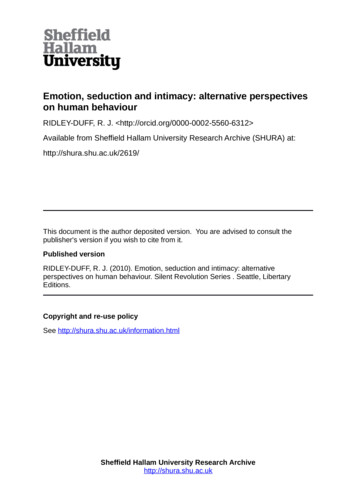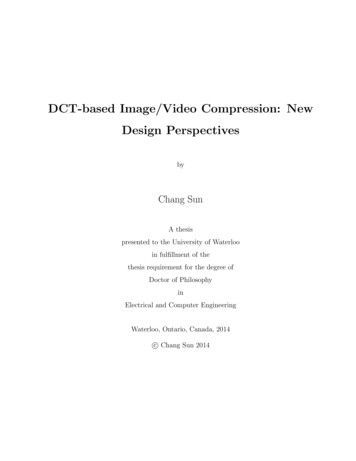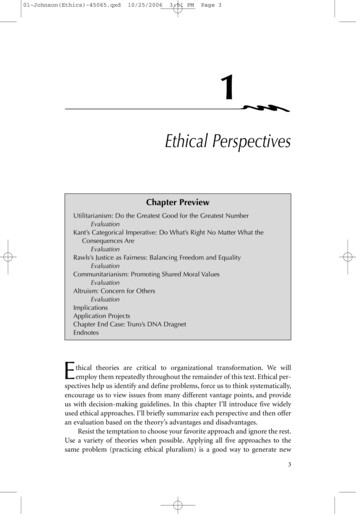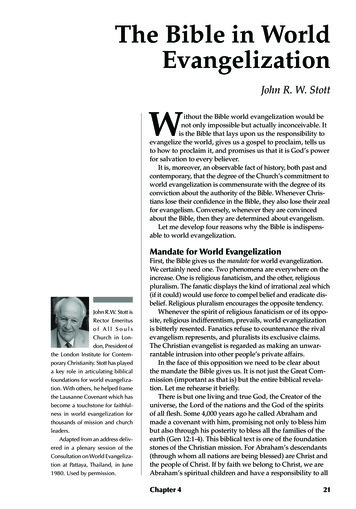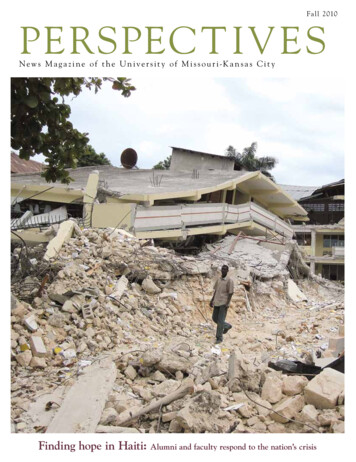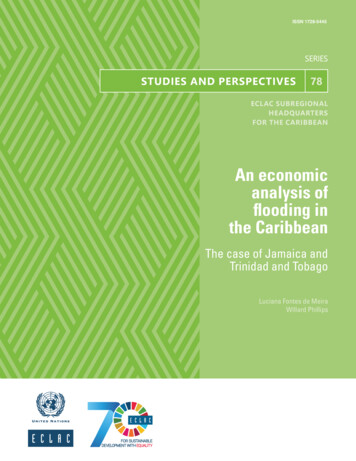
Transcription
ISSN 1728-5445SERIESSTUDIES AND PERSPECTIVES78ECLAC SUBREGIONALHEADQUARTERSFOR THE CARIBBEANAn economicanalysis offlooding inthe CaribbeanThe case of Jamaica andTrinidad and TobagoLuciana Fontes de MeiraWillard Phillips
Thank you for your interest inthis ECLAC publicationECLACPublicationsPlease register if you would like to receive information on our editorialproducts and activities. When you register, you may specify your particularareas of interest and you will gain access to our products in other al.org/apps
78An economic analysis of floodingin the CaribbeanThe case of Jamaica andTrinidad and TobagoLuciana Fontes de MeiraWillard Phillips
This document has been prepared by Luciana Fontes de Meira, Associate Environmental Affairs Officer, and WillardPhillips, Economic Affairs Officer, of the Sustainable Development and Disaster Unit of the ECLAC subregionalheadquarters for the Caribbean, with the assistance of Mauricio Gonzales, external expert on geographic informationsystems (GIS), for the map design and analysis. The authors also acknowledge the assistance of Shawn Campbell ofthe ECLAC subregional headquarters for the Caribbean, for his assistance in the conduct of field work in Trinidad, andMichael Wilson of the Water Resources Authority of Jamaica, for his support in the completion of the assessmentin Jamaica.The views expressed in this document, which has been reproduced without formal editing, are those of the authorsand do not necessarily reflect the views of the Organization.United Nations publicationISSN: 1728-5445 (electronic version)ISSN: 1727-9917 (print version)LC/TS.2019/55LC/CAR/TS.2019/1Distribution: LCopyright United Nations, 2019All rights reservedPrinted at United Nations, SantiagoS.19-00713This publication should be cited as: L. Fontes de Meira and W. Phillips. “An economic analysis of flooding in the Caribbean: thecase of Jamaica and Trinidad and Tobago”, Studies and Perspectives series-ECLAC subregional headquarters for the Caribbean,No. 78 (LC/TS.2019/55-LC/CAR/TS.2019/1), Santiago, Economic Commission for Latin America and the Caribbean(ECLAC), 2019.Applications for authorization to reproduce this work in whole or in part should be sent to the Economic Commission forLatin America and the Caribbean (ECLAC), Publications and Web Services Division, publicaciones.cepal@un.org. MemberStates and their governmental institutions may reproduce this work without prior authorization, but are requested to mentionthe source and to inform ECLAC of such reproduction.
ECLAC - Studies and Perspectives series-The Caribbean No. 78An economic analysis of flooding ContentsAbstract. 5Introduction . 7I.Flooding in the Caribbean . 9A. Trinidad and Tobago . 11B. Jamaica . 14II.Methodological approach. 19III.Selected areas of study . 25A. Socioeconomic profile of Chaguanas/Charlieville, Trinidad and Tobago .26B. Socioeconomic profile of Tunapuna/Piarco - Kelly Village/ St. Helena,Trinidad and Tobago . 27C. Socioeconomic profile of Saint Mary, Jamaica.29IV.Potential effects and mitigation measures . 31A. Trinidad and Tobago - Flooding in Tunapuna/Piarco and Chaguanas, a case studyof St. Helena, Kelly Village and Charlieville . 311. Effects . 312. Flood mitigation measures . 37B. Jamaica - Flooding in the Parish of St. Mary: A Case Study of Port Maria . 381. Effects . 382. Flood mitigation measures . 44C. Summary of analysis – two case countries . 44V.Conclusions . 47Bibliography .49Studies and Perspectives series-The Caribbean: issues published. 513
ECLAC - Studies and Perspectives series-The Caribbean No. 78An economic analysis of flooding TablesTable 1Table 2Table 3Table 4Table 5Table 6Table 7Table 8Table 9Table 10Table 11Table 12Summary of affected population and damage in the Caribbeanregion (1990 – 2018) .8History of disasters in Trinidad and Tobago . 12Catastrophic Hydrometeorological Events that have affected Jamaica:1933 – 2017 . 15Summary of elements considered in the analysis . 21DaLa methodology sectoral data map . 23Municipal Indicators – Chaguanas. 27Municipal Indicators – Tunapuna/Piarco . 28Municipal Indicators – St. Mary . 30Government budget transfer to individual producers . 36Summary of Flooding Costs - Trinidad and Tobago . 37Areas Suitable for Development in St. Mary and Specific Mitigations .44Summary of Flooding Costs - Trinidad and Tobago and Jamaica . 45FiguresFigure 1Figure 2Figure 3Figure 4Figure 5Figure 6Damage and affected people by disasters in the Caribbean . 102018 October flood - major impacts . 14Damaged premises of St. Helena Hindu Primary School in 2018 October Flood . 33Houses in Charleville area . 33Flooding at Port Maria Primary (top) and Secondary (bottom) Schools, 2012 . 41Debris deposits due to flooding – Port Maria Beach, May 2017 . 43BoxBox 1Financial protection in Trinidad and Tobago . 38MapsMap 1Map 2Map 3Map 4Map 5Map 6Map 7Map 8Map 9Map of flood prone areas of Trinidad highlighting study areas. 12Distribution of Flooding Events in Jamaica – as at 2010 . 16Flood Hazard Map – Jamaica . 17Flood risk in selected areas/ Rivers in selected areas, Trinidad . 25Flood risk in selected areas/ Rivers in selected areas, Jamaica .26Land cover type in study areas. 36Population Density – Jamaica (2011). 39Location of the Parish of Saint Mary, Jamaica . 39Flood Boundaries for Port Maria . 404
ECLAC - Studies and Perspectives series-The Caribbean No. 78An economic analysis of flooding AbstractFlooding as an extreme event has become progressively evident in the Caribbean sub-region, as a resultof an increased number of intense rainfall events, and storm surges from hurricanes. Such events in turn,have been linked to the impacts of global climate change, which has been shown to be the cause forseveral specific events including sea-level rise; global temperature rise, ocean warming andacidification, and the melting of glaciers. In the specific instance of the Caribbean subregion, floodingevents often result in significant disruptions of economic and social life. The study will use a case-studyapproach of selected areas in Trinidad and Tobago and Jamaica to investigate the potential economicimpacts of recurrent flood events and compare with a potential cost saving benefit of specific floodcontrol interventions. Previously developed maps and analysis of the spatial impacts of past flooding isused to define the specific geographical scope of the research in terms of exposure and vulnerability.The Damage and Losses Assessment methodology (DaLA) is used to estimate potential effects relatedto flood events. Planned government interventions in the selected areas will be used as a parameter ofcost of flood adaptation measures.5
ECLAC - Studies and Perspectives series-The Caribbean No. 78An economic analysis of flooding IntroductionThe occurrence of flooding has been increasing globally in recent decades. This phenomenon hasresulted in growing impacts, assessed in terms of damages, loss of life, and loss of economic output.According to Douben (2006), since the mid 1980’s, flooding has been the most frequently occurring, hasclaimed the highest number of human lives, and has generated the largest economic losses among allnatural hazards worldwide. Of some 7,000 recorded natural disasters, 75 percent were identified aswater- related events, of which floods were the most frequent, accounting for roughly one-third ofthese. Furthermore, when assessed in economic terms, floods were the cause of roughly 20 percent ofall losses for the 30 year period up to 2003. Such losses were estimated to be in the order of 208 billion,during the same period, with human casualties exceeding 184,000 between 1986 and 1995 alone(Douben, 2006). While the increase in flooding has been widespread on a global scale, specific regionshave suffered more events than others. Asia for instance experienced roughly 45 percent of all majorfloods between 1985 and 2003, with the Americas experiencing some 25 percent.Several factors have been identified as principal drivers for the enhanced pervasiveness andeffects of flooding around the world. Among these are the more widespread occurrence of heavy and/orlong-lasting rain, the increased intensity of precipitation in the form of brief but torrential rainfall, anda greater frequency of tropical cyclones and monsoon rains. With respect to impacts, flooding producesgreater human casualties and economic losses due to the rising share of global populations that havesettled on flood-prone areas.In the specific instance of the Caribbean subregion, flooding events often result in significantdisruptions of economic and social life. By way of examples, the island of Hispaniola has suffered severalflooding events over the past two decades, with one of the most significant causing loss of life of morethan 900 persons in Haiti and the Dominican Republic in 2004, and several repeated occurrences up to2017. Jamaica (2017, and 2018) has also experienced repeated flooding events, with the most recentoccurring in 2012, 2017, and 2018. Similar events have also been noted for several islands of the EasternCaribbean including Antigua and Barbuda (2010); Barbados (2010); the British Virgin Islands (2010,2017); Dominica (2013, 2017); Saint Lucia (2013, 2016); Saint Vincent and the Grenadines (2013); and7
ECLAC - Studies and Perspectives series-The Caribbean No. 78An economic analysis of flooding Trinidad and Tobago (2016, 2017, and 2018). Mainland Caribbean territories have also had theirchallenges with flooding, as was the experience of Guyana in 2005; Suriname in 2008; and Belize in 2015.Caribbean countries such as Jamaica and Trinidad and Tobago, face a potentially great reversal ineconomic and social improvements, at local level, due to weather related disasters such as flooding. Forinstance, their portfolio of investments and existing debt could be affected by spending shifts that forcethe diversion of resources destined for productive sectors and social spending into reconstruction efforts.Quantitative information on the effects and impacts of flooding is also useful when formulating long-termdevelopment plans with proper budgetary allocations to prevent future impacts and build resilience.Although systematic disaster loss accounting and comprehensive risk assessment do not guarantee moregovernment investments, they do encourage governments to identify possible trade-offs of investing inmitigation measures and help in informed decision-making (UNISDR, 2011). Unfortunately, this type ofanalysis is not systematically done for what are considered to be low-impact localized events such asriverine flooding. Between 1990 and 2018 for instance, only around 20 per cent of flooding that took placein the region have had overall damage reported to EM-DAT 1, in comparison to 44 per cent when it comesto storms (table 1). However, with high probability of occurrence of yearly flooding in certain areas, smallbut recurrent impacts such as lost hours of schooling by children and young people, and disruptions ofsmall businesses may cause long term consequences for the quality of life in the area. In spite of theirpersistent effects and long-term economic impacts, they often go unassessed.Table 1Summary of affected population and damage in the Caribbean region (1990 – 2018)Type of 044Total affectedpopulation6 077 60329 770 071Total damage ('000 US )1 460 082112 803 519Source: EM-DAT: The Emergency Events Database - Universite catholique de Louvain (UCL) - CRED, D. Guha-Sapir - www.emdat.be,Brussels, Belgium.On the basis of the above, the aim of this study is to undertake an economic analysis of costsassociated with flooding in selected areas and to create a model of analysis which could be reproducedin similar events. The study will focus on land-based flooding particularly in respect of potential riverine,and flash flooding events. The study uses the DaLA methodology as a basis for the cost assessments.Although a comprehensive Damage and Loss assessment as done by ECLAC in post-disaster situationswas not carried out, the aim of the paper is to demonstrate how the methodology can be used to assesslow-impact recurrent events such as flooding This is intended to be a pilot study which combines deskresearch complemented with data collected in interviews and field visits.It seeks to partition out potential costs specific to flooding events in selected locations, and todevelop a methodological approach for measuring such costs in a manner that can be replicated insimilar cases in other locations. The paper also aspires to demonstrate the importance of a systematiccollection of data related to such events in order to facilitate not only the recovery and reconstructionprocesses, but also to provide an evidence-based approach to planning and selecting floodmitigation measures.1EM-DAT contains basic data on the occurrence and effects of more than 22.000 disasters worldwide from 1900 to the present. Thedatabase is compiled from several sources, including UN agencies, non-governmental organizations, insurance companies, researchinstitutes and press agencies. This database defines a disaster as a situation in which at least one of these four conditions occurred:a) ten or more deaths; (b) one hundred or more people affected; (c) a state of emergency declared; (d) a call for internationalassistance made.8
ECLAC - Studies and Perspectives series-The Caribbean No. 78I.An economic analysis of flooding Flooding in the CaribbeanAlthough all nations are exposed to some type of natural event to a greater or lesser extent, their effectsdo not necessarily result in a disaster with the destruction of physical assets and deterioration of meansof subsistence for the population. Disasters result from a combination of two factors: (i) naturalphenomena capable of triggering processes that lead to physical damage and loss of human lives andcapital; and (ii) vulnerability of individuals and human settlements to such events. This vulnerabilitycould be related to infrastructure (no application of a building code), lack of land-use planning, socialfactors (poverty), or institutional framework (lack of proper disaster risk management policies).Vulnerability is a prerequisite (manifested during the disaster), as well as an indicator of the exposure ofthe physical and human capital, and of the capacity of individuals, households, communities andcountries to endure and recover from disasters (ECLAC, 2014). According to data collected from theEM-DAT platform, the average number of disasters per decade, as well as the affected population andthe magnitude of the damage suffered has increased significantly since the 1970s in the Caribbean.Analyzing the period between 1990 and 2017 in the region, 90.4 per cent of disasters were associatedwith hydro-climatic hazards, stressing the high occurrence of storms (58.1 per cent), and floods(27.2 per cent) (ECLAC, 2019). Although the number of deaths related to floods in the period has notbeen high, total affected population has been significant. Despite the recurrent disruptions cause byflooding, its effects and macroeconomic impacts have not been consistently measured, as normallythese are localized events when compared to hurricanes and storms which tend to have nationalimplications and receive more international attention. Of 119 flooding events recorded in the region inthe period from 1990-2018, only 23 have been assessed in terms of damage. While data on damagerelated to flooding have not been systematically measured, flood events have been reported every year,with economic figures only available for certain years (see figure 1).9
ECLAC - Studies and Perspectives series-The Caribbean No. 78An economic analysis of flooding Figure 1Damage and affected people by disasters in the Caribbean2503 000Damage (millions US )2 0001501 5001001 00050500Total 92019900Affected population (thousand)2 500200Total affected populationSource: EM-DAT: The Emergency Events Database - Universite catholique de Louvain (UCL) - CRED, D. Guha-Sapir - www.emdat.be,Brussels, Belgium, 2019.This historical profile of Caribbean flood em
mitigation measures and help in informed decision-making (UNISDR, 2011). Unfortunately, this type of analysis is not systematically done for what are considered to be low-impact localized events such as riverine flooding. Between 1990 and 2018 for instance, only around 20 per cent of flooding that took place
